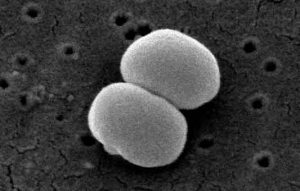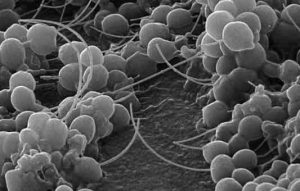
Staphylococcus epidermis
Photo Credit: Janice Carr Content Providers(s): CDC/ Segrid McAllister
Staphylococcus epidermidis is becoming resistant to most antibiotics and in parts of Europe some strains are already resistant to all known antibiotics (University of Melbourne).
Dr Jean Lee with her consultant and PhD supervisor, Professor Ben Howden identified three strains of the bacteria, which have become resistant to the two separate antibiotics currently used to treat infections – rifampicin and vancomycin.
Professor Howden, who remains a clinician and is also the Director of the Microbiological Diagnostic Unit Public Health Laboratory at the Doherty Institute, says this resistance is concerning because vancomycin in particular is used as a last line of defence against infections.
Staphylococcus epidermidis, a conspicuous member of the human microbiome, widely present on healthy skin, has also evolved to become a formidable nosocomial pathogen.
It is possible that hospital practices, such as antibiotic monotherapy utilizing rifampicin-impregnated medical devices, have driven the evolution of this organism, once trivialized as a contaminant, towards potentially incurable infections.

Staphylococcus epidermis 2
Photo Credit: ARTISMICROPIA
Using genomics, researchers reveal that three multidrug-resistant, hospital-adapted lineages of S. epidermidis (two ST2 and one ST23) have emerged in recent decades and spread globally.
These lineages are resistant to rifampicin through acquisition of specific rpoB mutations that have become fixed in the populations.
Analysis of isolates from 96 institutions in 24 countries identified dual D471E and I527M RpoB substitutions to be the most common cause of rifampicin resistance in S. epidermidis, accounting for 86.6% of mutations.
The study showed that these rpoB mutations not only confer rifampicin resistance, but also reduce susceptibility to the last-line glycopeptide antibiotics, vancomycin and teicoplanin.
The research has uncovered the previously unrecognized international spread of a near pan-drug-resistant opportunistic pathogen, identifiable by a rifampicin-resistant phenotype.
For more information
nature microbiology
Global spread of three multidrug-resistant lineages of Staphylococcus epidermidis
Link…
European Society of Clinical Infectious Diseases
CMI – Clinical Microbiology and Infection
Staphylococcus epidermidis: why is it so successful?
Link…
The University of Melbourne
Link…
MDN
This post is also available in:
 Italian
Italian


